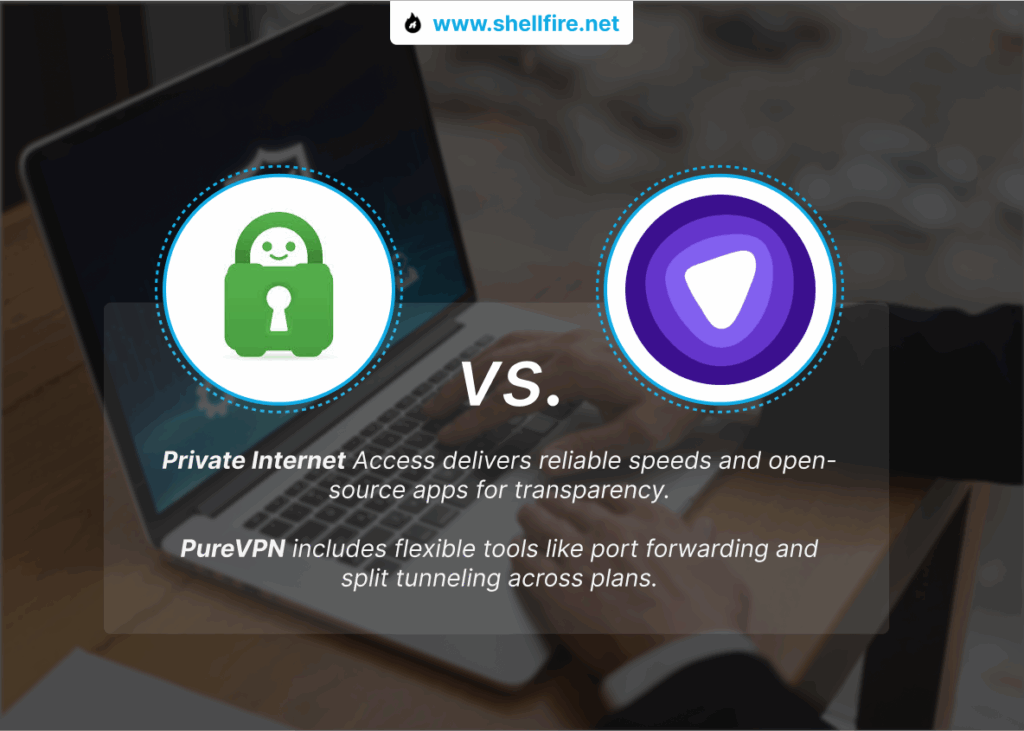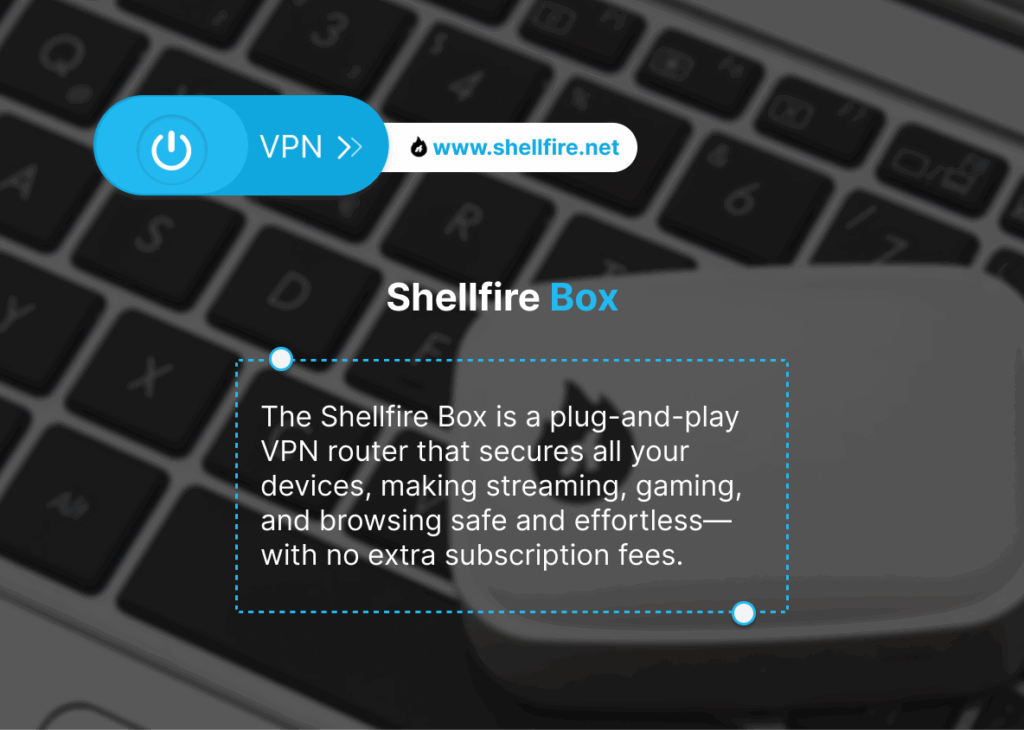Private Internet Access vs PureVPN
Choosing a VPN today isn’t just about picking the one with the most features, it’s about finding the service that fits your approach to online privacy and performance. With so many options on the market, it helps to compare services with clear, distinct philosophies like Private Internet Access (PIA) and PureVPN.
One embraces transparency and customization; the other focuses on ease of use and global accessibility. In this detailed comparison, we explore where each shines, where they fall short, and how those differences might align, or clash, with the way you browse, stream, and safeguard your data.
Table of Contents
Key Points
- Private Internet Access (PIA) stands out for its robust privacy approach, with independently audited no‑logs policies, full open‑source apps, and advanced configuration options, ideal for users who prioritize transparency and control.
- PureVPN offers a vast and flexible server infrastructure, easy-to-use streaming modes, and advanced encryption, suited for users looking for convenience and reliable access worldwide.
- Alternative VPN services include ultra-simple plug-and-play tools, privacy-first niche providers, and even hardware-based options for users who prefer different usability models.
Quick Comparison: PIA vs PureVPN
| Feature | Private Internet Access (PIA) | PureVPN |
|---|---|---|
| Headquarters | United States (14‑Eyes jurisdiction) | British Virgin Islands (outside 14‑Eyes) |
| Server Network | 90+ countries, bare‑metal/RAM‑only servers | 6 000–6 500 servers, 65–78 countries, includes virtual locations |
| Protocols | WireGuard, OpenVPN, IKEv2/IPSec | WireGuard, OpenVPN, IKEv2/IPSec (PPTP/L2TP/SSTP mostly deprecated) |
| No‑Logs Audit | Deloitte (2022) & independent (2024) | “Well‑known” auditor, unspecified; KPMG originally |
| Performance | ~10% speed reduction (PCMag) | ~61% download, ~79% upload via WireGuard (PCWorld) |
If transparency and minimal data retention are your priorities, PIA’s RAM-only server infrastructure and third-party audits make it a reassuring choice. Meanwhile, PureVPN brings to the table a vast number of global servers and advanced protocol support, great for users needing worldwide access, though speeds can vary.
Alternatively, for users seeking a balance between simplicity and core VPN functionality without sacrificing essential privacy, Shellfire VPN offers a straightforward, reliable solution. While it doesn’t match the advanced customization of PIA or the extensive streaming modes of PureVPN, its ease of setup and consistent performance make it a practical choice for those who prioritize a no-fuss experience over granular control.

Infrastructure & Global Coverage
| Metric | PIA | PureVPN |
|---|---|---|
| Countries | 90+ | 65–78 (some virtual) |
| Servers | Bare‑metal & RAM‑only; audited | 6 000+; many virtual servers |
| Audits | Deloitte (Jun 2022); internal audit (Jan 2024) | No‑log audit, identity undisclosed |
| Server Tech | RAM‑only wipes on reboot | Quantum‑resistant & virtual servers |
For users who care deeply about how their data is handled, PIA’s bare-metal and RAM-only design ensures that nothing is stored between sessions. With regular audits, this infrastructure speaks volumes about the provider’s transparency. PureVPN, while not always as clear about audit details, offers more global flexibility, especially helpful if location-switching or international travel is a frequent need.
Speed & Performance
| VPN | Protocol | Download (Mbps) | Upload (Mbps) | Latency & Stability |
|---|---|---|---|---|
| PIA | WireGuard | up to ~517 Mbps (user‑reported); peak ~436 Mbps in lab tests | up to ~616 Mbps (user‑reported) | Generally consistent, occasional regional slowdowns |
| PureVPN | WireGuard / OpenVPN | varied, but often mid‑hundreds Mbps | – | Inconsistent depending on server type (virtual vs bare‑metal) |
Switching to WireGuard has given PIA a notable performance edge, doubling speeds in some cases. Real-world users frequently report over 500 Mbps, a significant boost for gamers, streamers, and remote workers. PureVPN also provides solid performance, though speeds fluctuate more due to the mix of virtual and physical servers.
Security & Privacy
| Feature | PIA | PureVPN |
|---|---|---|
| Encryption | AES‑128 / AES‑256, ECC, RSA-4096, SHA‑256 | AES‑256 & RSA; quantum‑resistant keys available |
| Protocols | WireGuard, OpenVPN, IKEv2/IPsec | WireGuard, OpenVPN, IKEv2/IPsec |
| No‑logs policy | Audited by Deloitte and independent audits | Repeated third-party audits; VPN Trust Seal accreditation |
| Jurisdiction | USA (14‑Eyes) | British Virgin Islands (outside 5/9/14‑Eyes) |
| Kill switch | Yes | Yes (“Internet Kill Switch”) |
When it comes to encryption, PIA offers a broader range of options, allowing users to fine-tune for performance or security, including support for modern cryptographic tools like ECC and RSA‑4096. The open-source nature of its apps further adds credibility and transparency.
PureVPN has made strides too, notably with quantum‑resistant encryption through Quantinuum, appealing to users who want future-proof security. Its jurisdiction outside the 14-Eyes alliance is also a clear win for those concerned about surveillance partnerships.
That said, if privacy is your main concern, reviewing how ExpressVPN stacks up against CyberGhost may offer useful insight into jurisdictional strengths and audit transparency.
Streaming Performance
| Platform | PIA | PureVPN |
|---|---|---|
| Netflix | Works on select US regions; regional variability | Consistently unblocks US, UK, DE, CA reliably |
| Hulu | Occasional access, often blocked | Generally unblocks Hulu with dedicated mode |
| BBC iPlayer | Mixed results; requires trial/error | Dedicated streaming servers available |
| Amazon Prime | Functional but region‑dependent | Reliable with built‑in streaming mode |
If consistent access to global streaming content is your top priority, PureVPN performs better overall. Its dedicated streaming modes and server allocation ensure smoother, buffer-free access to Netflix, Hulu, BBC iPlayer, and Amazon Prime.
PIA can work for streaming too, but you may need to try multiple servers to find one that works for a particular platform or region.
For those comparing other streaming-oriented VPNs, exploring how NordVPN competes with PureVPN can also provide further perspective on usability and platform compatibility.
Looking for reliable streaming access across all devices?
Our Shellfire Box is designed to provide consistent access to your favorite streaming platforms, which can be a helpful solution if you’re experiencing issues with other VPNs.
Platform Compatibility
| Platform | PIA | PureVPN |
|---|---|---|
| Windows / macOS / Linux | Yes (open‑source clients) | Yes |
| iOS / Android | Yes | Yes |
| Routers | OpenWRT, DD‑WRT, Tomato | DD‑WRT, Tomato, ASUSWRT |
| Browser Extensions | Chrome, Firefox (M117+, WebSocket tunnel) | Chrome, Firefox |
| Consoles & Smart TVs | Via router / manual setup | Apps for Fire TV, Android TV; manual router for other consoles |
Both VPNs offer comprehensive multi-platform support. However, PIA’s open-source approach gives tech-savvy users added trust and flexibility, especially on Linux. PureVPN excels in user-friendly integration, particularly for smart TVs and consoles, with ready-made apps that remove the need for complex setup.
Performance in Censorship-Heavy Countries
| Country | PIA | PureVPN |
|---|---|---|
| China | Works with WireGuard and port-forwarding, but unreliable | Dedicated “NoBorders” mode; generally better in restrictive regions |
| Iran | Possible via manual settings | Better obfuscation and VPN protocols for censorship circumvention |
| Turkey/Russia | Mixed results | Stronger anti-blocking with obfuscated servers |
In regions where internet censorship is high, PureVPN has a distinct edge thanks to its NoBorders mode and obfuscation technologies, which are specifically designed to disguise VPN traffic. PIA can function with manual tweaks, but the setup requires more technical expertise and is less predictable.
User Experience & Apps
| Aspect | PIA | PureVPN |
|---|---|---|
| UI Design | Minimalist, complex settings available | Modern, category-based, onboarding wizard |
| Ease-of-Use | Geared toward advanced users | User-friendly for beginners |
| App Stability | Generally rock-solid | Stable on desktop, occasional mobile glitches |
If you’re looking for advanced control and configuration, PIA provides a clean, minimal UI with deep settings access. This is great for experienced users but can feel overwhelming to newcomers. PureVPN offers a more intuitive onboarding process and a visually guided interface, making it an appealing option for first-time VPN users.
Still, not every user needs the full suite of options or the most polished onboarding. The Shellfire Box offers a unique approach by extending VPN protection to all home devices without requiring app installations or complex configuration. For households or less tech-savvy individuals who want broad protection with minimal effort, it’s a compelling alternative that bypasses many usability hurdles common in software-based VPNs.
Customer Support
| Support Channel | PIA | PureVPN |
|---|---|---|
| Live Chat | No 24/7 chat; email ticketing only | 24/7 live chat often with quick response |
| 1‑2 day response time | Few‑hour typical response | |
| Knowledgebase | Comprehensive guides | Extensive guides plus video tutorials |
PureVPN clearly leads in customer support, offering responsive 24/7 live chat and an extensive support library complete with video tutorials. PIA relies on a more traditional support model, with no live chat and a slower email-based system. However, its in-depth documentation is useful for users comfortable troubleshooting on their own.
Additional Features
| Feature | PIA | PureVPN |
|---|---|---|
| Split Tunneling | Yes (per app) | Yes (per app) |
| Ad & Malware Blocking | MACE feature (desktop only) | Optional security add-ons |
| Port Forwarding | Yes (configurable) | No (restricted) |
| Dedicated IP | Available (paid) | Available (paid) |
| Automation / Scripts | CLI and scripting support | Limited automation features |
Both VPNs include a respectable set of extra tools aimed at advanced users. PIA leads with port forwarding, scriptable automation, and a CLI interface, giving tech-savvy users granular control. PureVPN compensates with easier security toggles and simpler setup of dedicated IPs and streaming features, which are better suited for non-technical users.
Alternatively, for users who don’t need advanced toggles but instead value simplicity and network-wide protection out of the box, the Shellfire Box introduces a hardware-based advantage. It delivers a streamlined set of VPN features designed to work seamlessly without complex app settings or manual configurations, ideal for everyday browsing, media consumption, and lightweight security needs across all household devices.
VPN Use Cases: Best Options for Streaming, Gaming, Torrenting & More
| Use Case | PIA Rating | PureVPN Rating |
|---|---|---|
| Streaming | ⭐⭐⭐ | ⭐⭐⭐⭐⭐ |
| Gaming | ⭐⭐⭐⭐⭐ | ⭐⭐⭐⭐ |
| Torrenting / P2P | ⭐⭐⭐⭐⭐ | ⭐⭐⭐ |
| Remote Work | ⭐⭐⭐⭐ | ⭐⭐⭐⭐ |
| Budget Users | ⭐⭐⭐⭐⭐ | ⭐⭐⭐⭐ |
| Censorship Countries | ⭐⭐⭐ | ⭐⭐⭐⭐⭐ |
Best VPN for Streaming
If your top priority is streaming access, PureVPN delivers superior results. With dedicated streaming modes, a large global network, and specialized servers for platforms like Netflix, BBC iPlayer, and Hulu, it minimizes the need for trial and error. PIA is capable, but often requires manual server switching to find one that works reliably.
That said, if your main concern is getting secure streaming across all devices in your home, without the need to configure apps or switch servers, Shellfire Box provides a distinct advantage. By securing your entire network at the router level, it can simplify streaming access on smart TVs, game consoles, and media boxes, making it an efficient solution for shared environments.

Best VPN for Torrenting / P2P
For torrenting, PIA is the standout. Its support for port forwarding, audited no-logs policy, and consistent WireGuard speeds make it ideal for users focused on secure and efficient file-sharing. PureVPN supports P2P but does not optimize as many servers specifically for this use case.
Best VPN for Gaming
Gamers will appreciate PIA’s performance with low-latency WireGuard tunnels and consistent speed. While PureVPN provides good routing options through its vast server list, latency can fluctuate more, especially on virtual servers. PIA offers a more reliable edge in fast-paced gaming scenarios.
However, for casual gamers or multi-device households looking for low-maintenance VPN integration, Shellfire VPN, especially when paired with the Shellfire Box, offers a steady and low-latency connection across consoles and PCs without per-device setup. It’s a worthwhile consideration for those who value convenience and consistent protection during gameplay.
Best VPN for Remote Work
Remote workers with strict data security standards will benefit from PIA’s transparency and robust encryption setup. However, PureVPN stands out for its ease of deployment and intuitive setup, making it easier for teams and less technical users to integrate the VPN into daily workflows.
Best VPN for Budget-Conscious Users
Both services offer competitive pricing and frequent long-term deals. PIA is often slightly cheaper over time and appeals to users looking for maximum value with minimal frills. PureVPN, on the other hand, runs attractive promotions and bundles that may suit users looking for extras and variety.
Best VPN for Censorship-Heavy Countries
In regions with aggressive internet controls, PureVPN has the advantage. Its NoBorders mode and protocol obfuscation tools are designed to slip past censorship blocks with minimal user intervention. PIA can function in such regions but typically requires more manual setup and expertise, which may not suit all users.
Conclusion
Deciding between Private Internet Access (PIA) and PureVPN ultimately comes down to what you value most in a VPN. If your priorities lie in transparency, granular customization, and audited privacy, PIA is a clear winner, especially for users who are tech-savvy, enjoy tweaking settings, or rely on VPNs for torrenting or competitive gaming. Its consistent WireGuard performance and open-source approach make it a trusted option for power users.
Meanwhile, PureVPN appeals strongly to users who want a VPN that works right out of the box. It’s better optimized for streaming, more approachable for beginners, and features strong global accessibility thanks to its broad server infrastructure. With support tools like 24/7 live chat and dedicated streaming modes, it’s especially well-suited for people seeking ease of use and hassle-free connectivity.
Both providers offer excellent long-term value and deliver a full spectrum of VPN features that serve different needs effectively. However, they aren’t your only options.
For those looking for a simpler, more accessible solution, Shellfire VPN and the Shellfire Box present viable alternatives. They combine essential VPN security with hardware simplicity, perfect for users who want instant protection across all their home devices without configuring software or navigating complex settings. These options stand out particularly for families, less technical users, or anyone who prefers a streamlined setup with reliable coverage.

